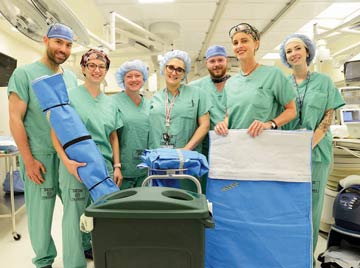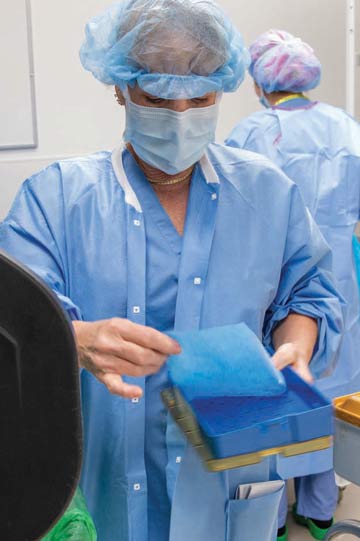There are many possibilities for greening a surgical facility, ?ranging from large, sweeping, expensive projects to small, focused, virtually free workplace hacks. Whether you spend hundreds of thousands of dollars, or a whole lot
less, there are many things you can do to reduce your facility's carbon footprint.
1Add LED lighting. Back in 2011, Boston (Mass.) Medical Center was launching a campus consolidation project that involved a lot of renovation and rethinking. Becoming more
sustainable in every area possible was a priority. Green energy savings were accounted for when the campus consolidation was costed out. As part of the project, BMC converted almost completely to energy-saving LED bulbs, which are more
expensive, but last longer and are more efficient. BMC installed 30 LED lights in its new hybrid operating room, and 30,000 LED lights all told throughout campus.
2Change anesthetic gases. BMC, like a growing number of surgical facilities, has moved away from desflurane in favor of sevoflurane because of the former's relatively huge
carbon footprint. Dave Maffeo, BMC's senior director of support services, says using desflurane for a two-hour surgery has the same environmental impact as driving a car 756 miles, as opposed to 16 miles using an equivalent dose
of sevoflurane. "It's huge for organizations that want to go green to make the change," he says.
3Capture waste gases. BMC installed wall-mounted canister systems in its ORs that capture all of the CO2 patients exhale. The carbon is absorbed in pellets that are safe to throw
away with other medical waste. "In a lot of facilities, that waste reaches the outside environment as greenhouse gas emissions," says Mr. Maffeo.
4Reprocess disposable devices. BMC works with a vendor that reprocesses single-use devices, says Mr. Maffeo. Not only does this prevent single-use devices from going directly to a
landfill, it also limits the need for BMC to buy reusable instruments and use resources to endlessly reprocess them.
5Trace the waste. Go on a "waste walk" to make sure the items you recycle aren't ending up in the regular trash, suggests Stephanie Barman, BSN, BA, RN, CNOR,
staff circulating nurse and GYN surgery coordinator at UnityPoint Health — Meriter, a partner of UW Health in Madison, Wis. During her walk, Ms. Barman was surprised to learn the items her team sorted into recycling bins in the
ORs were being thrown in a dumpster. She says following the waste stream through your facility to see the different steps in the process will reveal where problematic areas might be.
6Segregate at the point of use. Ms. Barman says recycling begins at the point of use. "As soon as packaging becomes garbage, when you open the item onto the sterile field,
that's when you should sort it," says Ms. Barman. The onus is on the OR staff to know what is and what isn't recyclable, but you can help their efforts by placing recycling bins in convenient locations next to trash
receptacles and hanging signage that displays the items that should be recycled.
7Understand the rules. A key aspect of getting a recycling program off the ground is knowing what's recyclable and what isn't — which varies depending on your
individual waste vendor. "I've learned that even if an item is marked recyclable, your vendor may or may not have the capability or the market to recycle that item," says Ms. Barman. "We found that out through a
few meetings with our waste vendor representative. Based on those consultations, nurses and techs received educational tools and information about what they can and cannot recycle.
8Always look for additional opportunities. It was during meetings with the waste vendor that Ms. Barman found out the vendor was able to recycle plastic wrap. Meriter OR staff
began saving plastic wrap for recycling by placing it in a large hamper provided by the vendor. When a bag is full, it's tied off, letting the evening housekeeping staff know it's ready to be moved to a designated spot on
the hospital's loading dock.
The results were mind-blowing. "After three months, I did the math on how many of the big bags we had gone through, and a friend who's a math teacher helped me determine the area of it," says Ms. Barman. She
calculated the plastic wrap they collected over three months would have filled 157 garbage trucks.
9Challenge vendors. Ms. Barman was frustrated she couldn't recycle the Styrofoam trays in her facility's custom packs, even though the trays had recycling numbers on
them. A process improvement engineer suggested Ms. Barman talk to the vendor who created the custom packs to find out if they had an alternative to Styrofoam. They did and as a result of Ms. Barman's willingness to ask, the packs
began arriving with recyclable cardboard trays. "You can actually feel empowered as the person who uses the product to talk to the vendor selling it and say, 'How can we do this differently?'" she says.
10Make it easy. Every custom pack at Meriter comes in a plastic bag, so Ms. Barman's team hangs the bags on hampers in the OR as they open the pack's supplies. The
team members toss the recyclable items from the packs into the bags in which the packs were shipped. It's full-circle recycling.
When done right, recycling becomes second nature. "We realized recycling has to be easy to do," she says. "Eventually, staff will do it without thinking. It's part of their muscle memory."
Creating awareness among staff is key. That mindset could produce more epiphanies like those experienced by Ms. Barman, who challenges you to think differently about surgical waste: "When you open something and don't use it
and it's still clean, always try to determine if there's a way to upcycle or recycle it."
— Joe Paone
.svg?sfvrsn=be606e78_3)


.svg?sfvrsn=56b2f850_5)